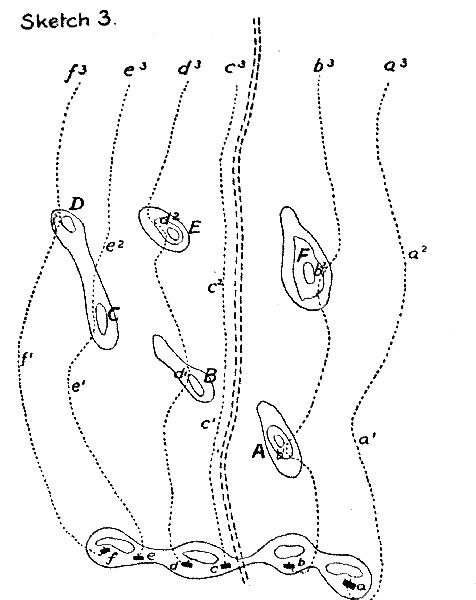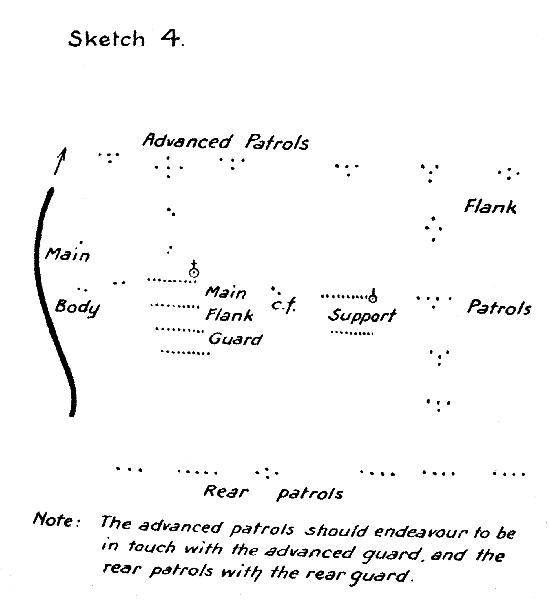Topic: AIF - DMC - Scouts
Scouting or Protective and Tactical Reconnaissance, Part 5
Frederick Allan Dove

3rd Light Horse Brigade Scouts in the hills at Tripoli, December 1918
In 1910, Major Frederick Allan Dove, DSO, wrote a book on a subject he was very familiar with through practical experience called Scouting or Protective and Tactical Reconnaissance. This book set the intellectual framework for the formation of the Brigade Scouts during the Sinai and Palestine Campaigns as part of the Great War.
Dove, FA, Scouting or Protective and Tactical Reconnaissance, 1910.
12. - Co-operation of Patrols.
In the mutual co-operation of the units composing the Screen lies the whole secret of success. The various patrols (twos or fours) assist each other's advance by outflanking positions which might afford cover to a few of the enemy. Supposing a small hill to lie in front of the centre of the line. The centre patrols would halt or advance cautiously, the flanking patrols would move on quickly to try and look behind the hill.
In Sketch 2 the patrol at A is halted ready to open fire if necessary. The patrols L3 and C are pushing out round the flanks of the farmhouse and plantation to B1 and C1. Should there be a "sniper" or two in hiding, he will probably consider it advisable to clear out before his retreat is endangered.
Should there be an attempt to cut off the advanced men at B1 and C1 the patrol at A are ready to cover their retreat.
Above all others the Directing Patrol is the One that must be protected and assisted in its advance. Sketch No.3 illustrates this. Tile country represented is undulating fairly clear of bush or timber.
a, b, c, d, e, f are patrols extended preparatory to an advance; c is the Directing Patrol, with which is the officer in charge. He looks over the country in front; he sees that the route runs between hills A and 13, and that his right patrols must scout A before he can get ahead. He signals to a and b to advance. They move as shown by the dotted lines; when at al and b1 respectively, they signal "No enemy in sight"; the O.C. at once motions to d, e, and f to move and c also advances; the leader of patrol d sees that he must outflank the hill B in order to protect the directing patrol, therefore he pushes ahead. When c reaches c1 the left patrols are at d1, e1, f1. Meantime a and b patrol leaders note the hill F and move forward to Scout it, similarly d and e notice hill E; the leaders know that c cannot pass between E and F till they are known to be clear, and so they move on; f meantime outflanks the ridge C, D; so that we next have the line of patrols at a2, b2, c2, d2, e2, f2- The country being flat and clear in franc, the patrols resume a general line, a3, P, c3, d3, e3, f3.
13. Contact with the Enemy.
It must be impressed on Scouts that their business is not Fighting, but Observation. This will not be understood to mean that they are not to capture or disable an enemy's Scout if the chance occurs. But once the enemy are located, or have disclosed themselves by opening fire, the immediate function of the Screen has been fulfilled.
When suddenly fired upon it should retire, but no further than is necessary to prevent useless loss of life. Under these circumstances patrol and troop leaders rally their men tinder the nearest suitable cover. It is at this time that the enemy is most likely to disclose his positions, owing to, his excitement and to the fact that he is not being fired at. It is now that our Special "Observers" referred to in (A) 6 have the opportunity of proving their value. By keeping cool, and if they have carefully chosen their own line of advance, they may gain most important information. The opportunity may be a fleeting one. Hence the necessity of having some one detailed for the duty. "What’s everybody's business is nobody's business."
Should the enemy be encountered advancing, it, is a case of patrol versus patrol. Theirs must be checked and prevented from obtaining a view of our columns. The screen which is composed of well-organised patrols can always put up a good fight if compelled. The ultimate action of Course depends upon the decision of the O.C. Advanced Guard.
Our Scouts may perchance discover the enemy retiring. Instant report must be made to the O.C. Vanguard. At the same time, while keeping closely on the enemy's trail, on no account should fire be opened.
In every case of contact with the enemy the Scouts absolutely fall in their duty if they do not remain in touch with him at all hazards.
14. - Summary of Instructions regarding the Advanced Guard Screen.1. The Screen to be thoroughly organised before extension; direction and frontage clearly explained to every man.
2. After extension, Keeping Touch, Observation, Communication the main points to observe,
3. Co-operation by patrols the secret of success.
4. Directing Patrol to maintain the true line of advance and regulate the average pace.
5. "Observers" to be detailed.
6. Advancing enemy to be delayed. Halted enemy to be drawn into disclosing his positions. Retiring enemy to be kept touch with, but not to be attacked without orders.
7. Passing of verbal and written messages to be constantly practised.
8. The halted Screen to become a Line of Observation Posts.
9. Reports to tell, if possible:Where are the enemy?
How many are there?
What are they (cavalry, infantry, &e.)?
What are they doing?
10. Touch with Scouting Troops to be maintained by Connecting Files. Signallers may be used if they call conceal their movements from ground possibly held by the enemy.
Previous: Part 4, Patrol Formations
Next: Part 6, Lecturettes
Further Reading:
Obituary, Frederick Allan Dove
Australian Light Horse Militia
Battles where Australians fought, 1899-1920
Citation: Brigade Scouts, Scouting or Protective and Tactical Reconnaissance Part 5 Co-operation of Patrols









